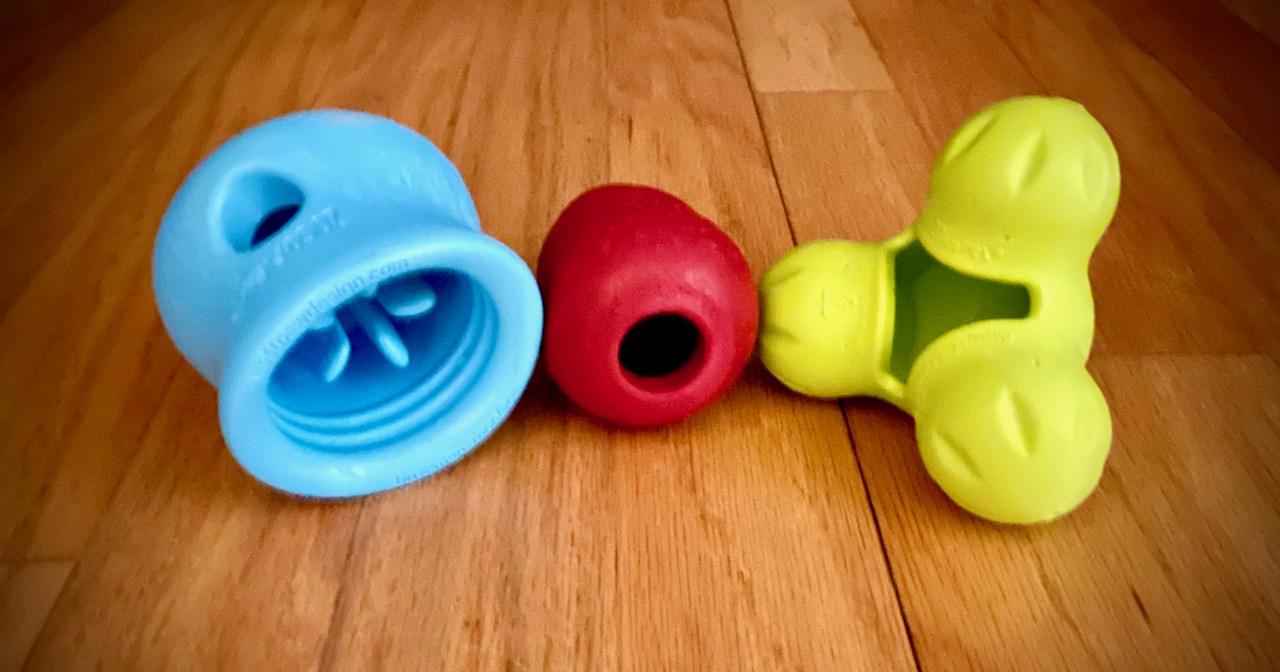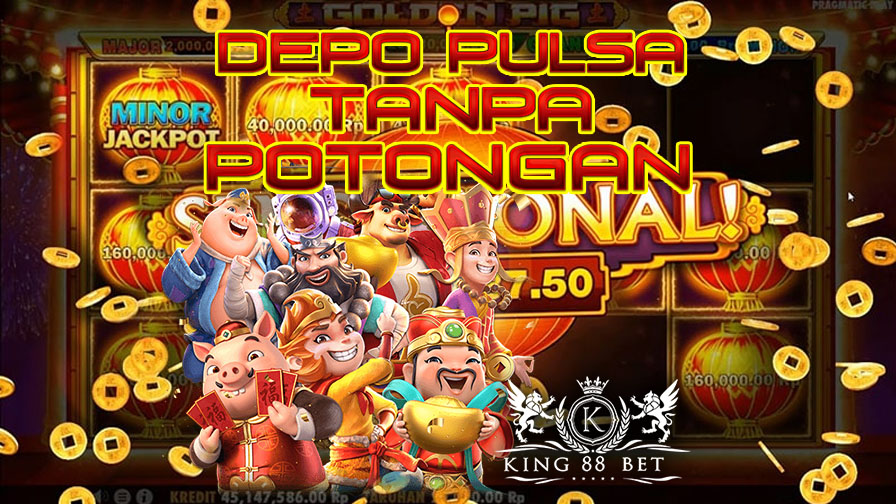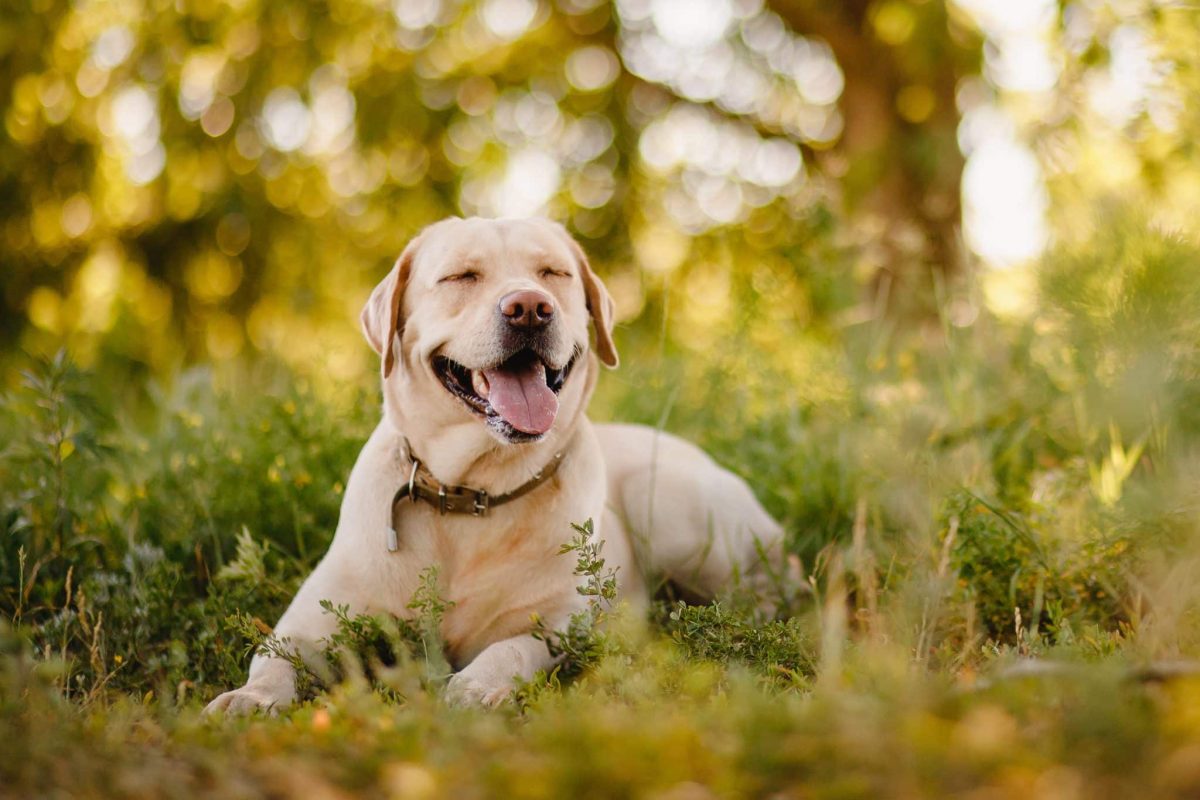Can you tell which one of the food toys in the photo above likely offers the highest rate of reinforcement when full? Your dog knows!
Lewis taught me this lesson. He is happy to lick and munch on a Kong (center) stuffed with frozen food when there’s nothing else going on. But if he’s excited in the car, he will ignore a Kong full of the same food. It’s not high enough value in that situation, but the same food in a “Toppl” toy (left) is.
What makes the difference if the food is the same? It’s the rate of reinforcement. The rate from these two toys is drastically different. This is because of the larger available surface area of the Toppl and the lack of the “bottleneck” effect of the Kong.
Another factor that affects the rate of reinforcement is whether the food is frozen. Frozen food is slower to come out of the toys. Lewis has also demonstrated that cool or room temperature food is more enticing, since it raises the rate of reinforcement even higher.
These are very basic observations, but I had never thought about them systematically before.
Food Toys and the Matching Law
Toys vary in the accessibility of the food because of their design and mechanics, and dogs must often perform multiple behaviors to get the food out. If you watch your dog eat out of a food toy from beginning to end, you can see great examples of the matching law.
The matching law tells us that we (animals including humans) perform behaviors in a ratio matching the ratio of available reinforcement for those behaviors. Food toys can give us real-time examples of a dog changing behaviors to optimize what pays off the most at any given moment.
It’s easiest to understand with two toys filled with the same food. If a dog can get food out of Toy A much faster than Toy B, they will empty most of A before they switch to B. They will switch when B’s rate of reinforcement becomes higher than A’s.
But we can also see it with one toy, as a dog changes their behavior to use the most effective one at that moment to get the food out.
Food Toys and Operant Learning
Let’s back up a little, because we might not be accustomed to thinking about operant learning regarding food toys. We usually think in terms of training: humans giving cues and the dogs responding. For instance, my dogs go to their mats when I cue them to do so because I have given them food hundreds of times for that behavior.
How is a food toy like that? A food toy provides cues, too! These visual, audible, kinesthetic, and olfactory cues indicate there is food inside and how much of it there is. The toy ejects or allows access to food as a consequence of different behaviors the dog performs. The rate of reinforcement changes during the process, depending on how much food is still in the toy and other factors. The matching law comes in as the dog varies their behavior for optimal reinforcement at each stage as the toy empties.

It’s the same with an open bowl of food; the process just goes a lot faster. The rate of reinforcement is much higher at the beginning when the dog can take big bites of food than it is at the end when there are only a few pieces left, then crumbs. There are still multiple food accessing behaviors. These include:
* walking to the food bowl;
* scooping up the food with their mouths;
* licking the bowl; and
* searching for spilled food outside the bowl.
Every dog who eats out of a bowl is “food motivated.” It’s just very easy work, for most.
Most food toys follow a similar reinforcement pattern: the rate of reinforcement is higher at the beginning than at the end. A few have a “hump” of difficulty to get over at the start, then a high rate of reinforcement that tapers off like the others. I have reviewed a toy called the Foobler that deviates from this typical progression enough that it would confuse or frustrate some dogs.
I’m going to offer some observations I’ve made about different types of food toys: their rates of reinforcement and my dogs’ behaviors in response.
Wobble Toys: The Kong Wobbler, Nina Ottosson Pyramid, and Others
These hard plastic toys have a weight on the bottom and turn themselves upright after movement like inflatable punching bags. Food spills out of a hole when they tip, so dogs learn to push them with their noses and manipulate them with their paws to make that happen. The rate of reinforcement changes depending on how much food is in the toy. If there is, say, a half a cup of kibble in the toy, almost every movement is going to knock some out at first.
The behaviors I’ve seen dogs perform to access the food are:
* approaching the toy;
* knocking the toy over with their paw;
* pushing the toy over with their nose from the top of the toy (rare; I’ll explain why);
* pushing the toy from the bottom with their nose;
* rolling the toy on its side in a circle with their nose;
* searching for kibble that may have scattered away; and
* coming to me for help with the last bits.
If frustrated or left too long with the toy, a dog may also bite at the opening or where pieces join.
In the beginning, the dog may be eating constantly for a couple of minutes. But as the toy empties, it takes more work, more movements to get each piece of food out. At the end, there may be two or three intransigent pieces of food that require several minutes of work to access. The rate of reinforcement is very high at the beginning, slows down as the dog must work harder to get the food, then is very low at the end when there are only a couple of pieces left. A dog with less experience or who isn’t hungry might give up and leave those last pieces of kibble. It might not be worth the effort. My dogs learn that I will pick up the toy and help them with those last few pieces.
I hadn’t realized until I watched the video that Clara has a sequence of behaviors she usually uses with a Wobbler toy. First, she knocks it over with her paw. Then she pushes it in a circle with her nose. If she pushes the toy with her nose when it is standing, she pushes the base. Her method prevents the toy from punching her in the nose.
My partner’s small dog either got punched in the nose or saw the risk of it. I introduced her to the smaller Wobbler. It has a proportionately heavier weight in the bottom and the movement is stiffer. It’s harder to push over and comes back up more forcefully. After a couple of pushes, she would not interact with it. We switched quickly to a different type of toy, and I filed that bit of information away for future reference.
Rolling Toys
Rolling toys have a reinforcement schedule similar to the wobbler types. A lot of food comes out at first, then the amounts diminish as the dog rolls the toy around. I’ve noticed that when the rate of reinforcement gets low, Lewis will take a break and scout around for any kibble he may have knocked out before and not noticed. Matching law! He may get more pieces of food in 20 seconds of scouting the area than in 60 seconds of pushing the almost-empty ball around.
The food seeking and accessing behaviors I’ve observed Lewis doing are the following:
* finding the ball (I vary its placement);
* pushing the ball with his nose;
* rolling it with his foot;
* carrying the ball to a different place;
* leaving the ball and searching the area;
* when indoors, reaching under closed doors to try for kibble that escaped; and
* sitting by those same doors to get me to open them.


I pay attention when he carries the ball. He may do it to get the ball to a more optimal area, say, away from another dog who is giving stink-eye from the other side of a baby gate. But carrying can also be a precursor to trying to chew up the toy. That happens especially when the rate of reinforcement gets low. This, too, reflects the matching law. The time it takes to get those last couple of pieces of kibble out can be very long, but chewing can be reinforcing in itself and can happen immediately. And who knows, you might get to the kibble that way. (I confiscate the ball at that point, trading a few pieces of better food for it.)
Mild mannered Summer ate out of the Tricky Treat ball for much of her life and never tried to chew it up. She got every piece of food out, though. She loved the toy; she learned its name and could find it on cue. Here’s an adorable video of that for the Summer fans.
Clara, on the other hand, chewed almost every toy I had when she was a youngster, before I learned to supervise her better. The only toy that proved impervious was the Ottosson pyramid.
Snuffle Mats and Food Scattering
Snuffle Mats have reinforcement schedules similar to those of the preceding toys. The rate of reinforcement is richer at the beginning, then thins out as there is less kibble available and more searching necessary. But in my observation, they are easier than most other toys at the beginning and at the end, and the rate of reinforcement doesn’t change as much as with the wobblers or balls. The food is more accessible in general, even to an inexperienced dog. There is little manipulation involved; it’s mostly the nose!
Scattering food on the floor around the house or on the ground outside can be a similar exercise. But if you scatter it evenly over a large area, there won’t be a high rate of reinforcement at the beginning. Although finding food on the ground is something most dogs learn easily, it pays to make this exercise very simple at first. If I were to spread a half cup of kibble over my back yard as my puppy’s first scent exercise, they’d give up fast. The rate of reinforcement would be low to start with and fall to zero if they didn’t move out of the original area, which they wouldn’t know to do. Their food seeking behavior would go into extinction in that situation. You can start with an area of a few square feet (an invisible snuffle mat), then enlarge it as the dog gains skill and an understanding of the game.
I mentioned above that Summer loved her Tricky Treat Ball. What does she tell us in this video about the differing rates of reinforcement between the ball and a snuffle mat?
Sound alert: there are jingling tags in the video.
Toys for Soft Food: Kongs, Westpaws, and Others
These container type toys can be stuffed to be very easy (high rate of reinforcement from the very beginning) or harder. If you have never used one of these toys, check out my video, “Kongs for Beginners.” It’s easy to make these toys too difficult at first. Also read further in this post, because I made that video in 2012; there are now much easier toys of this type to start with.
When first introducing these toys, use very yummy food at room temperature so the dog has immediate access to it and can learn some moves for manipulating the toy. But because freezing them increases the differences in the rate of reinforcement, I’m going to discuss frozen ones.
Now we are going to revisit my opening point: toys with bigger openings have a higher rate of reinforcement for the dog.
Although the orange Topple in the photo contains more food overall, that’s not the most important point. The surface area is bigger, and more food is accessible than in the Kong, even if the dog can only lick it. The rate of reinforcement depends on the size of the opening, what behaviors can be used to get the food out, the rate of thawing, and the size of the dog compared to the size of the toy. At the beginning, the dog can lick at the food and scrape their bottom teeth at it. As the food thaws, the toy becomes more flexible and more chewing methods are possible.
The Toppl starts off with a moderate rate of reinforcement when frozen. The dog can lick, scrape their bottom teeth against the food, and bite at the rim area with their top teeth. There is more room to get their teeth in. A lot of the food is exposed to air and can thaw pretty fast. As the food thaws, the rate of reinforcement speeds up even more, until the end where it slows down as they get the last bits of food out. The Kong, on the other hand, starts out hard. The food opening is small, and the frozen solid toy offers little access to the food. It thaws slowly as the dog at first can only lick and scrape their teeth against the small opening. There may be some power chewers who can crush a frozen Kong in their teeth so the food crumbles and comes out faster. But even for those dogs, the Toppl would likely still be easier.
Dogs can build some interesting skills with Kongs. Besides licking at the contents and chewing around the hole, some dogs learn to toss the Kongs in the air so the contents will loosen and fall out.
Takeaways
* Observe your dog with a food toy and count the different behaviors. It’s fun and you may learn something.
* Watch for true enjoyment. Just because something is called a food toy doesn’t mean a dog will enjoy it, or enjoy it at that moment.
* Watch out for frustration. Not only is it unpleasant for the dog when behaviors stop working (go into extinction), this situation predicts that the dog’s behavior will vary more. This is when they might start chewing the toy rather than working to get the food out. So watch closely when they are finishing up the food.
* Supervise, supervise, supervise. Do better than I did with Clara. Chewing hard plastic can be dangerous; swallowing it can be fatal.
I plan at least two more posts on dogs and food toys: one on contrafreeloading and one on whether licking is intrinsically more calming than chewing.
I’d love to hear about your dogs’ unique approaches to food toys!
Copyright 2023 Eileen Anderson





